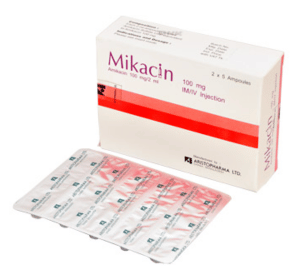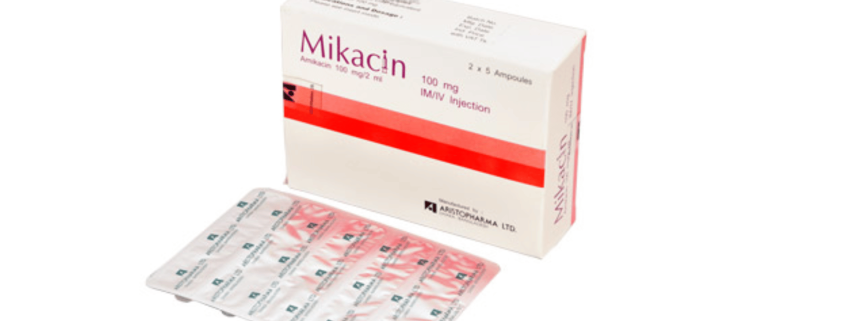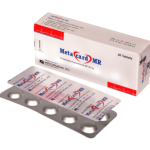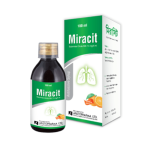Mikacin (Amikacin Sulfate)

Therapeutic Group : Antibiotic
Presentation:
Mikacin 100 IM/IV Injection: Each 2 ml ampoule contains Amikacin 100 mg as Amikacin Sulfate USP.
Mikacin 500 IM/IV Injection: Each 2 ml ampoule contains Amikacin 500 mg as Amikacin Sulfate USP.
Indications:
Amikacin sulfate injection is indicated in the short-term treatment of serious infections due to susceptible strains of Gram-negative bacteria. Amikacin sulfate injection is effective in bacterial septicemia (including neonatal sepsis); in serious infections of the respiratory tract, bones and joints, central nervous system (including meningitis) and skin and soft tissue ; intra-abdominal infections (including peritonitis); and in burns and post operative infections (including post vascular surgery). Amikacin is also effective in serious complicated and recurrent urinary tract infections due to Gram-negative organisms. Amikacin may be considered as initial therapy in suspected Gram-negative infections and therapy may be instituted before obtaining the results of susceptibility testing. Clinical trials demonstrated that amikacin was effective in infections caused by gentamicin and/or tobramycin-resistant strains of Gram-negative organisms. Amikacin is also effective in staphylococcal infections and may be considered as initial therapy under certain conditions in the treatment of known or suspected staphylococcal disease such as severe infections where the causative organism may be either a Gram-negative bacterium or staphylococcus, infections due to susceptible strains of staphylococcal/Gram-negative infections. In certain severe infections such as neonatal sepsis, concomitant therapy with a penicillin type drug may be indicated because of the possibility of infections due to Gram-positive organisms such as streptococci or pneumococci.
Dosage & Administration:
Adults and children: 15 mg/kg/day in two equally divided doses (equivalent to 500 mg b.i.d. in adults): USP of the 100 mg/2 ml strength is recommended for children for the accurate measurement of the appropriate dose. Neonates and premature infants: An initial loading dose of 10 mg/kg followed by 15 mg/kg/day in two equally divided doses.
Elderly: Dosage should be adjusted under impaired renal function. Life-threatening infections and/or those caused by Pseudomonas: The adult dose may be increased to 500 mg every eight hours but should neither exceed 1.5 g/day nor be administered for a period longer than 10 days. A maximum total adult dose of 15 g should not be exceeded. Urinary tract infections (other than pseudomonal infections): 7.5 mg/kg/day in two equally divided doses (equivalent to 250 mg b.i.d. in adults). As the activity of amikacin is enhanced by increasing the pH, a urinary alkalising agent may be administered concurrently.
Impaired renal function: In patients with impaired renal function, the daily dose should be reduced and/or the intervals between doses increased to avoid accumulation of the drug. Simple doses schedule for renal impairment is given below:
• Mild impairment: 500 mg every 18 hours.
• Moderate impairment: 500 mg every 24 hours.
• Severe impairment: 250 mg every 24 hours.
Intramuscular or Intravenous Administration: The intramuscular route is preferred for most infections, but in life-threatening infections or when an intramuscular injection is not feasible, an intravenous infusion may be used.
Intraperitoneal use: Amikacin may be used as an irrigant after recovery from anaesthesia in concentrations of 0.25%.
Other routes of administration: Amikacin in concentrations of 0.25% may be used satisfactorily as an irrigating solution in abscess cavities, the pleural space, the peritoneum and the cerebral ventricles.
Contrainidications:
Hypersensitivity to any of the components of the product, myasthenia gravis.
Side effects:
When the recommended precautions and dosages are followed the incidence of toxic reactions, such as tinnitus, vertigo, partial reversible or irreversible deafness, skin rash, drug fever, headache, paraesthesia, nausea and vomiting is low. Urinary signs of renal irritation (albumin, casts and red or white blood cells), azotaemia and oliguria have been reported. There have been reports of retinal toxicity following intravitreal injection of amikacin.
Drug interaction:
Concurrent use with other potentially nephrotoxic or ototoxic drug substances should be avoided. The risk of ototoxicity is increased when amikacin is used in conjunction with rapidly acting diuretic drugs, particularly when the diuretic is administered intravenously. Such agents include frusemide and ethacrynic acid, which is itself an ototoxic agent. Irreversible deafness may result. The intraperitoneal use of amikacin is not recommended in patients under the influence of anaesthetics or muscle-relaxing drugs as neuromuscular blockade and consequent respiratory depression may occur. Indomethacin may increase the plasma concentration of amikacin in neonates. In patients with severely impaired renal function, a reduction in activity of aminoglycosides may occur with concomitant use of penicillin-type drugs.
Use in special groups:
Pregnancy category D. Safety in pregnancy is not established. It is not known whether amikacin is excreted in breast milk. Since the possible harmful effect on the infant is not known, it is recommended that if nursing mothers must be given amikacin, the infants should not be breast fed during therapy.
Packing:
Mikacin 100 IM/IV Injection: Each box contains 10’s ampoule in blister pack.
Mikacin 500 IM/IV Injection: Each box contains 5’s ampoule in blister pack.



